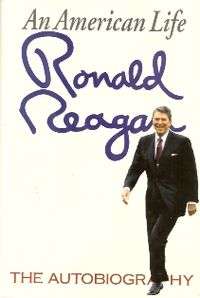An American Life
 | |
| Author | Ronald Reagan |
|---|---|
| Country | United States |
| Language | English |
| Genre | Memoir |
| Published | November 15, 1990 Simon & Schuster |
| Media type | |
| Pages | 748 |
| ISBN | 0-7434-0025-9 |
| OCLC | 48994916 |
An American Life is the 1990 autobiography authored by former American President Ronald Reagan. Released almost two years after Reagan left office, the book reached number eight on The New York Times Best Seller list.[1]
Content
The book is composed of 748 pages, describing Reagan's life from his birth in Tampico, Illinois, to his acting career, marriages, entrance into politics, years as Governor of California, loss in the 1976 Republican primary, and finally his years as President of the United States. Reviewer John O'Sullivan says of Reagan, "[H]e shows a tendency, where other people's feelings are concerned, to gloss over unpleasantness in a way which does him credit as a Christian, but detracts somewhat from his value as a historian."[2] He revealed the events that led to his reluctant 1976 candidacy, as well as his relationships with members of Congress and his views on the world and the Cold War.[3]
Personal life
Reagan was married twice: the first to actress Jane Wyman (1917–2007) from 1940 to 1948. Reagan only mentions her in one paragraph in the book, saying "it didn't work out" but that the marriage "produced two wonderful children."[4] He married Nancy Davis in 1952, saying in the biography "Sometimes, I think my life really began when I met Nancy."[5]
Presidency
The book covers most of the events that occurred during the Reagan presidency (1981–1989). The most notable omission is that Reagan does not discuss the rejection of Robert Bork as a Supreme Court justice, and in fact makes very little mention of his judicial appointments. One of Reagan's more controversial enactments as president were his economic policies, dubbed "Reaganomics." From Reagan's point of view, everything about them were successful except that "the vested interests that hold sway over Congress prevented us from cutting spending nearly as much as I had hoped to, or as the country required."[6] Also in terms of economic policy, one of Reagan's main regrets was that he was ultimately unsuccessful in creating a balanced federal budget.
Speaking of the Iran-Contra affair, a Reagan administration scandal that involved the diverting of funds being shipped to Iran to the contras in Nicaragua, Reagan says, "None of the arms we'd shipped to Iran had gone to the terrorists who had kidnapped our citizens."[6] Of the scandal, Reagan writes, "[Bud] McFarlane, [John] Poindexter, [Bob] Casey, and, I presume, [Oliver] North knew how deeply I felt about the need for the contras' survival as a democratic resistance force in Nicaragua. Perhaps that knowledge... led them to support the contras secretly and saw no reason to report this to me." He also says of himself, "As president, I was at the helm, so I am the one who is ultimately responsible."[7] Also, Reagan discusses his political rivalry and personal friendship with former Speaker of the House Tip O'Neill.
Reviews
When the book was first published, it reached number eight on The New York Times bestsellers list.[1] Some authors, journalists, and reviewers agreed that the book presented a fair picture of Reagan's life,[2][6][8][9] while others questioned its purpose and historical value.[10]
References
- 1 2 "Best Sellers:December 30, 1990". The New York Times. 1990-12-30. Retrieved 2007-12-25.
- 1 2 O'Sullivan, John (1991-02-11). "Reagan's Life". National Review. Retrieved 2007-12-26.
- ↑ "An American life". alibris.com. Retrieved 2007-12-26.
- ↑ Reagan, Ronald (1990), p. 92
- ↑ Reagan, Ronald (1990), p. 123
- 1 2 3 Lehmann-Haupt, Christopher (1990-11-05). "Books of The Times; How Ronald Reagan Overcame Doubts and Became President". The New York Times. Retrieved 2007-12-28.
- ↑ Reagan, Ronald (1990), p. 486-487
- ↑ An American Life. Amazon.com, Inc. ISBN 0743400259.
- ↑ An American Life. Amazon.com, Inc (United Kingdom). ISBN 0671691988.
- ↑ Dowd, Maureen (1990-11-18). "Where's the Rest of Him?". The New York Times. Retrieved 2007-12-28.
